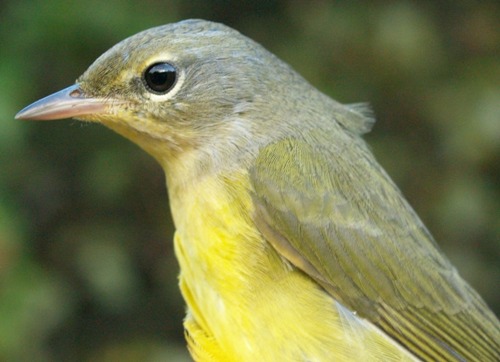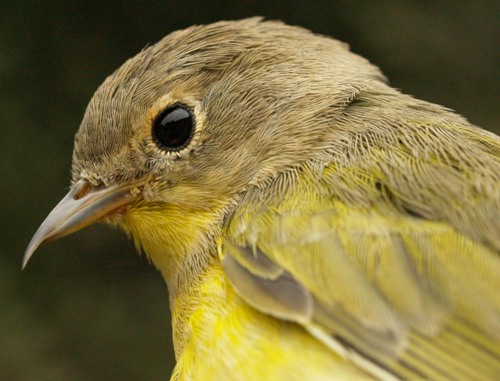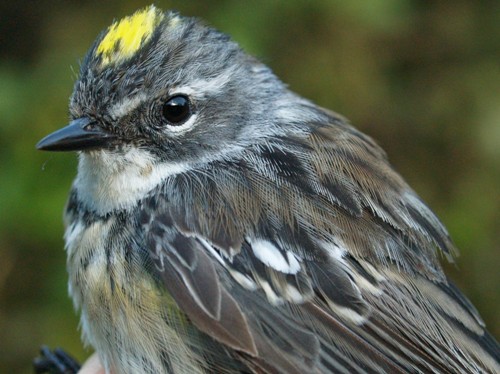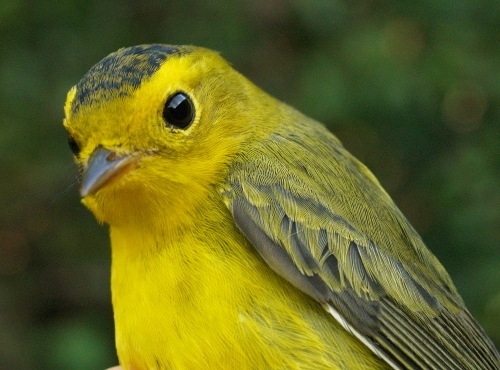|
Week 5: August 29 - September 4, 2011 |
Welcome
to the McGill Bird Observatory weekly report.
Click here for a complete listing of our archives.
Comments or
questions are welcome at "mbo AT migrationresearch.org".
|
PICTURE
OF THE WEEK: |
|

Ovenbirds are passing through MBO in good numbers this fall, with the 36 banded to
date already representing an above-average total for the season, and no doubt at
least a few more yet to come in September.
(Photo by Simon Duval)
-
|
|
|
THIS WEEK |
THIS FALL |
2011 TOTAL |
SITE TOTAL |
|
# birds (and species) banded |
311 (36) |
1083 (55) |
2171 (74) |
33740 (108) |
|
# birds (and species) repeat |
39 (13) |
210 (27) |
365 (37) |
5872 (68) |
|
# birds (and species) return |
2 (2) |
13 (7) |
108 (20) |
915 (37) |
|
# species observed |
86 |
107 |
146 |
202 |
|
# net hours |
531.6 |
2555.1 |
5392.1 |
55009.2 |
|
# birds banded / 100 net hours |
58.5 |
42.4 |
40.3 |
61.3 |
|
|
Note: table does not include nocturnal banding (owls) |
|
Bander-in-charge: Simon Duval, Gay Gruner
Assistants: Mike Beaupré, Sue Bishop, Rui de Jesus, Jean Demers, Andrée-Anne Deschamps, Tammy Elliott, Lima Kayello, Lisa Keelty, Louise Lebel, Francine Marcoux, Daniel Martin, Barbara MacDuff, Chris Murphy, Catherine Russell, Ahmad Shah, Clémence Soulard, Bonnie Soutar, Elise Titman, Rodger Titman
Notes: This week started off with a very slow Monday, and we thought that the yo-yo season of busy/slow weeks was going to continue. But then on four other days during the week we banded 50 or more birds, bringing our total for the week to 311 - for the second week in a row, a record. After the strong pulse of migration over the past two weeks, our season total now stands at 1084, slightly ahead of last year's record pace, while the 55 species banded to date is just below average for this time of fall.

While warbler numbers have overall been great so far this fall, the increased abundance is not uniform. This Mourning Warbler was only the seventh banded at MBO this fall, and being an early migrant, the total may not rise much further, which could result in a record low count for fall.
(Photo by
Simon Duval)

Continuing the "confusing fall warbler" comparison from last week, Nashville and Mourning Warblers can appear similar. The yellow throat and more complete gray hood of the Nashville Warbler set it apart; this particular individual is noteworthy for its overgrown upper mandible.
(Photo by
Simon Duval)
|
So far our count of species observed this season has been lagging behind past years, but with the ten species added this week, the total of 107 nearly matches our six-year average for the end of week 5. The newcomers were Common Merganser, Double-crested Cormorant, Greater Yellowlegs, Northern Harrier, Yellow-billed Cuckoo, Winter Wren, Northern Parula, Wilson's Warbler, Rusty Blackbird, and House Finch. The merganser, yellowlegs, and cuckoo were also new for 2011, and the cuckoo was only the fourth one in MBO's history, following two in 2005 and one last August. We added Yellow-bellied Sapsucker, Yellow-rumped Warbler, and Wilson's Warbler to our list of species banded this fall, but none of them were new for the year.
This week’s top 10 [last week's rank in brackets]
# individuals banded |
mean # individuals observed daily |
1. Magnolia Warbler (79) [1] |
1. Canada Goose (36) [-] |
2. Tennessee Warbler (52) [3] |
2. Cedar Waxwing (32) [1] |
3. American Redstart (26) [2] |
3. American Crow (23) [4] |
4. Nashville Warbler (22) [7] |
4. Black-capped Chickadee (23) [3] |
5. Northern Waterthrush (15) [-] |
5. Magnolia Warbler (17) [10] |
5. Wilson's Warbler (15) [-] |
6. American Goldfinch (15) [6] |
7. Yellow-bellied Flycatcher (8) [-] |
7. Tennessee Warbler (10) [-] |
7. Common Yellowthroat (8) [5] |
8. American Redstart (10) [8] |
9. Ovenbird (7) [5] |
9. American Robin (8) [7] |
10. Chestnut-sided Warbler (7) [4]
|
10. Nashville Warbler (6) [-] |
|
Warblers were again dominant in the nets this week, with the only exception in the top ten being Yellow-bellied Flycatcher in seventh place. Magnolia Warbler took top spot, as it has every year in week 5. Second place was secured by an impressive wave of Tennessee Warblers - we have never before banded more than 20 in a week in fall, and in three of our previous six years, our total for the entire season was lower than the 52 banded this week. American Redstart numbers remained strong, while Nashville Warblers are increasing as we head into September, consistent with the normal trend. There was a sudden spike in Northern Waterthrush numbers this week, similar to what we observed in week 5 last year. Wilson's Warbler also jumped into the top ten this week with 15 birds banded, right in line with the typical peak of migration for this species. Common Yellowthroat remained in the top ten, although the total of 48 banded to date this fall is somewhat below normal for this time of year. Ovenbird and Chestnut-sided Warbler rounded out the top ten this week, with both species on pace for potentially record high totals this fall.
Canada Goose came from out of nowhere to take top spot this week on the list of species observed, similar to what happened this week in 2009. That pushed Cedar Waxwing down to second place, still the best ever showing for the species at this time of year, with the previous high daily mean being only 16, half of what we observed this week. American Crow and Black-capped Chickadee swapped third and fourth place this week, although just by a matter of a couple of individuals, as both rounded off to a daily mean of 23 individuals, similar to last year's numbers. The four warblers that topped our banding list this week were common enough to dominate the middle/lower part of the list of species observed, joined by American Goldfinch, holding steady in sixth place, and American Robin hanging on in ninth spot. Somewhat surprisingly, this is the first time we have had more than two warbler species on the list in week 5.
|

This scruffy-looking Yellow-rumped Warbler was the first of its kind banded at MBO this fall, but we expect the main migration is still at least another couple of weeks away.
(Photo by
Simon Duval)
 Also banded for the first time this fall were Wilson's Warblers, with this being one of 15 that visited our nets this week.
Also banded for the first time this fall were Wilson's Warblers, with this being one of 15 that visited our nets this week.
(Photo by
Simon Duval)
|





